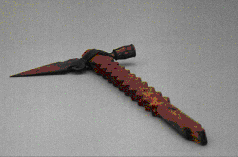
The Blackfoot natives are one of the oldest linguistic groups on the Plains. They occupied the Lethbridge area prior to European settlement. The Blackfoot were perfectly adapted to living in a vast open landscape. They were nomads who roamed the plains in the summer and used the shelter of the river valleys in the winter. However, the settlement of Europeans dramatically affected the Blackfoot's life style.

P19641141000-GA Ceremonial trade hatchet, this particular piece dates back to 1800. It would have been used by fur traders dealing with natives.
The introduction of the C.P.R. brought changes to the Blackfoot nation that meant their lifestyle would be forever different. The C.P.R. was met with limited resistance from the natives in the region because of cooperation of Crowfoot, the leader of the Blackfoot. Instead of resorting to violence he decided to allow the CPR to trespass onto native land. This decision impacted the Lethbridge area and radically altered the future of the Blackfoot people. The result meant that settlement and industrialization would soon expand on Native land because of the fast paced transportation of goods that the rail offered.

P19738948000-GA This Monitor Pipe is a ceremonial pipe which is believed to have been used by the Peigan tribe during the 1800s.
These changes in lifestyle resulted in change or adaptation of a past occupation to fit current needs. This is evident in that the C.P.R. began to employ native people. One such job was to find lost railroad workers. The following bit of information was posted on the C.P.R. staff bulletin:
"On the occasion of the Company's Jubilee celebration , it was recalled that many workers in the wilder parts of the country relieved the monotony by going into the virgin forests to hunt and fish. Many of them disappeared in this way, some returning after weeks of wandering and others meeting death by drowning. Finally Indians were hired with the sole occupation of tracking down lost and strayed workers and bringing them back to camp." (taken from Canadian Railway Stories)
Previous Page | Exhibit Contents | Home | Navigation Information | Glossary | Curriculum Guide | Next Page
Copyright © 1996 Sir Alexander Galt Museum. All rights reserved.